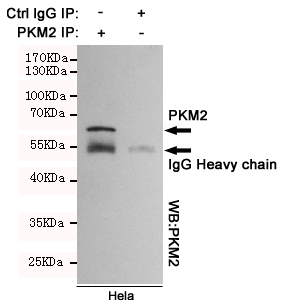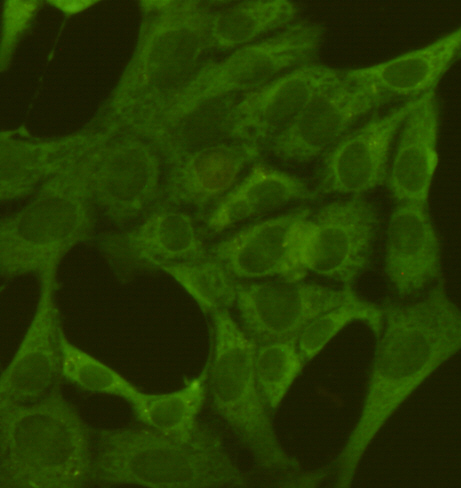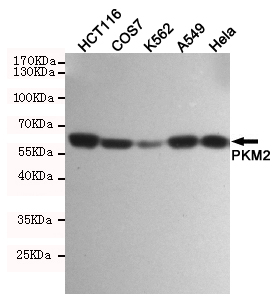-
Product Name
Anti-PKM2 (1F2) Mouse antibody
- Documents
-
Description
PKM2 (1F2) Mouse monoclonal antibody
-
Tested applications
WB, ICC/IF, IP
-
Species reactivity
Human, Mouse, Monkey
-
Alternative names
CTHBP ;Cytosolic thyroid hormone binding protein ;Cytosolic thyroid hormone-binding protein ;KPYM_HUMAN ;MGC3932 ;OIP 3 ;OIP-3 ;OIP3 ;OPA interacting protein 3 ;Opa-interacting protein 3 ;p58 ;PK muscle type ;PK antibody; muscle type ;PK2 ;PK3 ;PKM ;PKM2 ;pykm ;Py antibody
-
Isotype
Mouse IgG2b
-
Preparation
Antigen: Purified recombinant human PKM2 protein fragments expressed in E.coli.
-
Clonality
Monoclonal
-
Formulation
PBS(pH 7.4) containing with 0.03% Proclin300 and 50% glycerol.
-
Storage instructions
Store at 4°C short term. Store at -20°C long term. Avoid freeze / thaw cycle.
-
Applications
WB: 1/1000
;ICC: 1/500
;IP:1/20
-
Validations

Immunoprecipitation analysis of Hela cell lysates using PKM2.

Immunofluorescent analysis of 3T3 cells fixed by anhydrous methanol for 2 h at -20u2103 and using anti-PKM2 mouse mAb (dilution 1:500).

Western blot detection of PKM2 in HCT116,COS7,K562,A549 and Hela cell lysates using PKM2 mouse mAb (1:1000 diluted).Predicted band size:60KDa.Observed band size:60KDa.
-
Background
Swiss-Prot Acc.P14618.Glycolytic enzyme that catalyzes the transfer of a phosphoryl group from phosphoenolpyruvate (PEP) to ADP, generating ATP. Stimulates POU5F1-mediated transcriptional activation. Plays a general role in caspase independent cell death of tumor cells. The ratio betwween the highly active tetrameric form and nearly inactive dimeric form determines whether glucose carbons are channeled to biosynthetic processes or used for glycolytic ATP production. The transition between the 2 forms contributes to the control of glycolysis and is important for tumor cell proliferation and survival.
Related Products / Services
Please note: All products are "FOR RESEARCH USE ONLY AND ARE NOT INTENDED FOR DIAGNOSTIC OR THERAPEUTIC USE"
